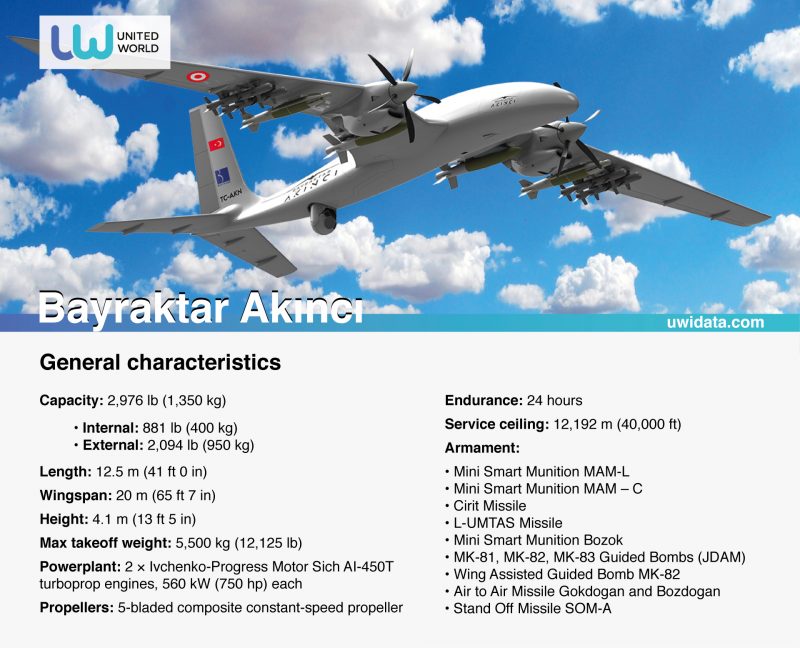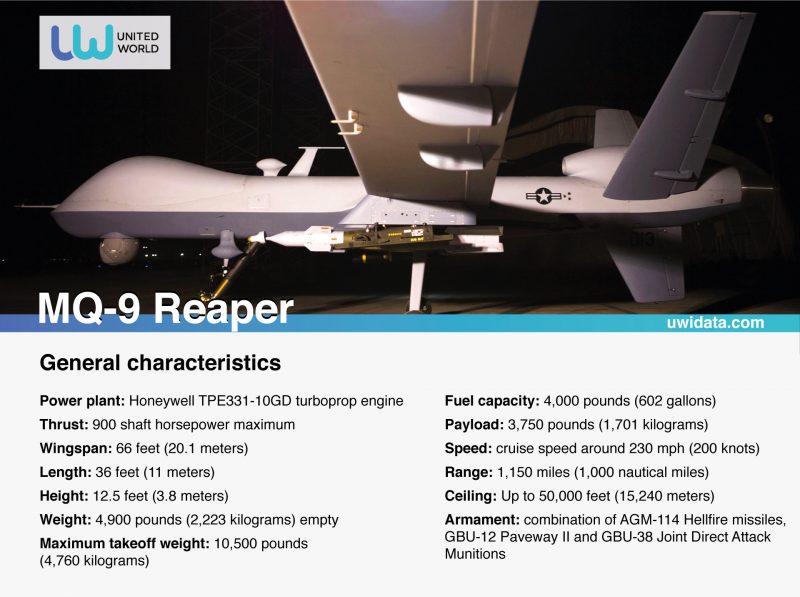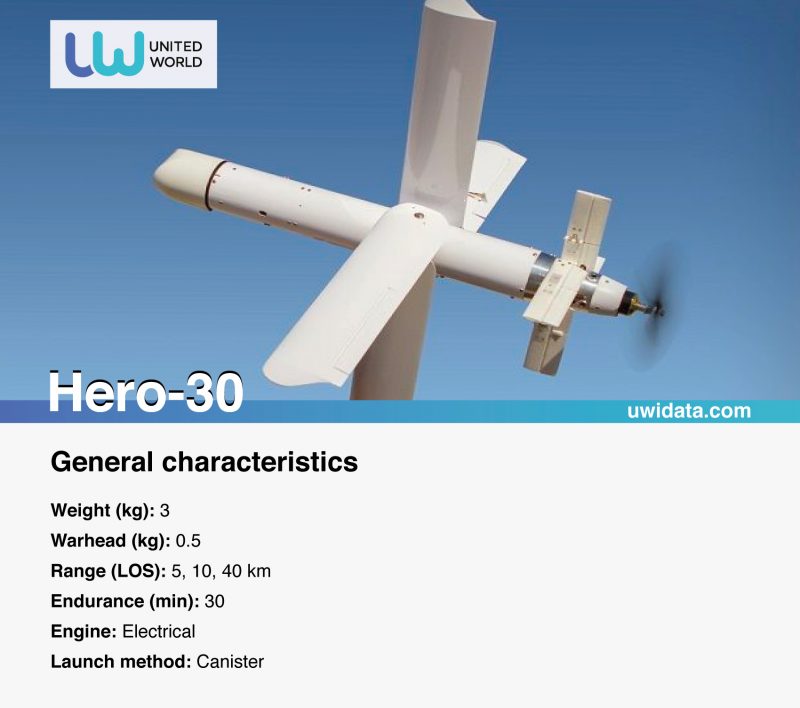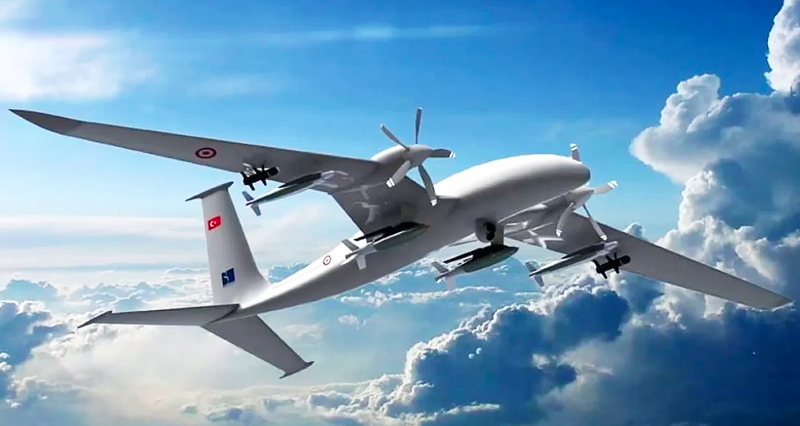The most notable weapons during the Karabakh war were Turkish and Israeli-made drones. The conflict demonstrated their effectiveness in modern warfare and convinced many to reconsider their approach to air defense.
The next round of the Karabakh conflict came at a time when unmanned aerial vehicles were developing particularly rapidly and drones were demonstrating impressive successes.
As The Financial Times noted, Nagorno-Karabakh became the fifth conflict zone where Turkish weapons were used. Before that, it was actively used in Libya, Syria, northern Iraq and in the Eastern Mediterranean.
According to experts, The Washington Post Turkish UAVs played a key role in changing the balance of power in Libya in favor of the Turkish-backed PNC government in Tripoli, and helped Azerbaijan defeat Armenia in Karabakh.
Turkish MALE class drones, which stands for “medium altitude, long endurance,” and Israeli “kamikaze drones” were widely used in the Karabakh war. According to various military experts the drone warfare was crucial for the military victory of Azerbaijan, because their attacks made Armenian infantry disoriented.
“Armed drones electronic war systems have helped Turkey to carry out a more hard power-oriented foreign and security policy. Because what it did is it essentially allowed Turkey to rely on its technological edge – which is now allowing Turkey to engage in this cross-border power projection, and reliance on hard power much more than in the past,” Sinan Ulgen of the Istanbul-based Center for Economics and Foreign Policy Studies told Voice of America.
Twenty years ago, Turkey did not have its own drones. But the country’s military industry has since created one of the world’s best classes of weapons with its characteristics and demonstrated its effectiveness in Karabakh. The victory of Turkish weapons in Nagorno-Karabakh means that drones are becoming one of the important tools to resolve long-standing conflicts.
In the future, we will see more and more widespread use of drones on the battlefield. The use of drones removes the obstacles (including psychological ones) for massive use of air power.
“The use of drones by both Armenia and Azerbaijan, which possess only a limited number of legacy aircraft, represents the removal of both technological and cost barriers that are normally associated with the traditional means of delivering airpower. In this way, drones have acted as an enabler, facilitating the use of airpower by actors who would otherwise be prevented from generating, or have limited access to it at scale,” British expert Edward Davies notes.
Drones and the future of warfare
The active use of unmanned aircraft in the early 2000s was an important advantage for the United States. The first known use of UAVs as fighter aircraft dates back to November 2001, when a Predator drone was used to kill Mohammed Atef, one of the military commanders of al-Qaeda in Afghanistan.
The Barack Obama administration initiated an extensive program of drone strikes in the Middle East and Africa. The victims were not only terrorists, but also civilians, primarily in countries such as Yemen and Somalia.
The way the US has approached the use of drones – deploying bases on other continents as part of the war on terror and using drones for point-blank strikes – also resulted in a violation of territorial sovereignty.
Thus, the drone warfare by the US contributed to the new – highly globalized landscape of war.
In drone warfare, the side sending the weapons suffers no casualties. This factor contributes to an increase in the use of both strike and reconnaissance drones. There is a lack of transparency and accountability, and a further loosening of the political and international law constraints associated with drone warfare.
Thus the increased importance of drones on the battlefield may lead to de facto proliferation of conflict and the removal of many of the factors that previously deterred conflict.
As noted by researcher Ian G. R. Shaw, who advanced the concept of the “Predator Empire”, drones are beginning to act as tools of biopolitics, threatening certain “patterns of life that are coded, catalogued, and eliminated”, not only certain individuals and groups. It is creating conditions for “a permanent war.
Drones and Air Defense
An important factor that will certainly drive the proliferation of drone warfare is the effectiveness of UAVs against Air Defense systems, including highly sophisticated ones like Russian Pantsir, which were destroyed by Turkish drones in Libya and Nagorno-Karabakh.
Efficient counteraction against drone attacks requires an effective radar reconnaissance system, streamlined data processing system, instant response, targeting of firing means, application of electronic warfare systems and echeloned air defense system (simultaneous application of different types of air defense systems).
This is available to developed states and only if they engage in high costly full-flagged war. But in small conflicts, in clashes with Third World armies, or in the cases of use of expeditionary forces abroad, use of PMCs in conflicts in the “gray zone”, such use of air defense systems is not to be expected.
Individual air defense systems used outside of echeloned systems, as the experience of Libya and Nagorno-Karabakh shows, are unable to resist drones.
Therefore use of drones is a chip and effective (since drones are more cheaper and easier to use than the air defense systems ) means to overcome the air defense in the majority of modern conflicts.
Drones and information warfare
As the experience of the Karabakh war shows, the use of drones also helps win on the front of information. Drones are equipped with a camera and can replicate a picture of the enemy’s relentless and effective defeat. An adversary who does not use drones himself cannot counteract anything. This is similar to the effect of the US Operation Desert Storm, where the US demonstrated the power of its war machine through shots of accurate cruise missiles and bombing runs. Drones allow us to do the same, but at a lower cost.
Leading players
The pioneer of widespread use of unmanned aircraft was the United States. In addition to the United States, China, Turkey and Israel are considered leading players in the market. All of these countries not only have combat drones, but also the ability to produce and export combat drones themselves.
Turkey
The Turkish Bayraktar TB2 is Turkey’s most famous strike drone. It was used in Libya against General Haftar’s forces. In Karabakh, TB2s operated as part of Azerbaijani forces along with Israeli kamikaze drones.

Today Bayraktar Akıncı is so far the most advanced strike drone of the Bayraktar family.
Currently, the most modern Turkish Bayraktar Akıncı drones from Baykar Makina have AI-450 engines from the Ukrainian company Motor Sich, but soon the Turkish company TUSAS will release its TEI PD-222 engine and possibly equip its new Baykar drones and drones with it.
Recently Baykar Makina defense chief Selcuk Bayraktar announced the beginning of intensive development of the next-generation attack fighter UAV, MIUS. The company hopes to complete development of the fighter UAV by 2023.
Another latest Turkish drone, the TAI Aksungur, entered serial production in December 2020. It is a multi-purpose aircraft designed for visual and radio, reconnaissance, maritime patrol and as a strike drone. The drone was developed by Turkish Aerospace Industries (TAI), which produced the TAI Anka series of multipurpose drones.
TAI is also developing the supersonic Goksungur UAV.
Aksangui and Akıncı UAVs will also be able to engage flying objects (helicopters, drones and aircraft) thanks to their missile armament.
US
For a long time the most famous unmanned strike system in the world was the American MQ-1 Predator, later on its base was created a heavier MQ-9 Reaper.

MQ-9 Reaper is one of the mightiest strike drones in the world capable of carrying up to 1.7 tons of payload. The Bayraktar TB2, by comparison, can carry only 150 kilograms. The MQ-1 and MQ-9 are the main strike drones used by the US. In addition, the US uses reconnaissance drones, both small – RQ-11, and heavy – RQ-4 Global Hawk.
Among other important US combat drones are the RQ-170 Sentinel (one was shot down by the Iranians in 2011), and the Boeing X-37 – classified robotic spacecraft.
The US budget for the production of combat drones is increasing from year to year, which corresponds to the US desire to achieve complete hegemony in the air.
In early 2015, the US Army began developing an open architecture that would combine manned and unmanned platforms. In order for soldiers to easily control unmanned assets, the Army will rely on artificial intelligence.
In December 2020, the US Air Force named Boeing, General Atomics, and Kratos as companies that would develop AI elements developed during the Skyborg. As the US Internet site the Drive notes, the aim is to acquire “a suite of artificial intelligence-driven capabilities that will be able to control loyal wingmen, as well as fully-autonomous unmanned combat air vehicles, or UCAVs”.
On December 4, General Atomics (maker of the Reaper and Predator drones) said that it successfully used an artificially intelligent software program developed by the US Defense Advanced Research Projects Agency (DARPA) in developmental drone Avenger.
China
The United Arab Emirates struck targets in Libya using Chinese-made Wing Loong II drones, which were used against Turkish Backed forces of the Government of National Accord. China sells it and another MALE-class drone, the CASC Rainbow, to a dozen and a half countries in Europe, Asia and Africa.
In the past 20 years, China has made a big leap in the production of combat and reconnaissance drones. China now produces miniature, micro (MAVs), and unmanned combat air vehicles (UCAVs), unmanned blimps, rotary-wing UAVs and many other types of drones.
The researchers at the University of Pennsylvania and Texas A&M University affirm that ” China has dominated the export market for armed UAVs. Of the 18 countries that have acquired armed drones since 2010 (not including China), 11 have bought from China.
China’s invasion of the global drone market is changing the balance of power in the world. Previously, the US refused to sell drones to “non-democratic countries”. Drones were seen as a weapon that gave an advantage to certain US allies and the Americans themselves. However, China has shattered US hegemony in this area.
Chinese armed forces are training to apply drone warfare in the same manner as the Americans. For example, they prepare to use the swarms of drones in combat and have plans to integrate artificial intelligence (AI) for drones.
Li Yidong, chief designer of China’s Wing Loong series drones declared that Chinese want their drones to “have smart situational awareness, capable of identifying targets and automatically make some decisions.
Israel
Israel is also the country that is called “drone superpower. Its “kamikadze” drones (small loitering munitions) were successfully tested in the Karabakh war. Israel is emphasizing the production of such systems (e.g. miniature Hero-30) rather than medium-altitude UAVs.

A number of experts consider tactical drones, which Israel is now actively developing, the next step in the development of drone technology. Tactical drones can be used by infantry and special units in combat. Their use increases lethality and makes drone warfare all-pervasive.
At the same time, Israel is also producing the IAI Heron TP the most advanced strategic reconnaissance drone and other similar drones of the Heron family.
All other countries that do not produce drones find themselves vulnerable to the leaders in this industry. Now it is even such leaders in military industries as Russia, France, UK, and Italy that either do not produce drones themselves or are just beginning to produce their tactical versions. Britain is involved in joint projects with Israel and the United States, but cannot fully autonomously produce and export drones.
The case of Iran that despite all the sanctions manage to start producing its own combat UAVs is important. They understand that in ЧЧШ century it is impossible to have full sovereignty without autonomous drone power.
In a world where unmanned systems (not just airborne, but also land and seaborne) will play an increasing role in geopolitics, Turkey has an important geopolitical and technological advantage.
Risks of drone warfare
Nevertheless, there are also dangers of expanding the use of drones:
1. Hacking UAVs: Like any high-tech weapon, drones can be hacked. There is a danger that hackers or terrorists could take control of strike drones or obtain sensitive information from intelligence systems. In the event of war, these actions could be carried out by the enemy.
2. Expanding the autonomy of robotic systems. The expansion of artificial intelligence capabilities increases the temptation to increase the autonomy of combat drones. However, a failure in algorithms can lead to fatal errors. The human factor is not only a source of possible problems. It is also a flexible control tool.
3. The use of drone technology by terrorists. For example, ISIS used armed civilian drones for their attacks. The simplest quadcopters turn into weapons of terrorist and guerrilla warfare. The PKK also used self-made drones for the attacks against Turkey.
In general, the proliferation of new warfare technology carries many risks, although it gives advantages to a number of states, including Turkey. At the same time, new weapons that are affordable and effective can help unfreeze many long-standing conflicts and intensify already ongoing ones. This imposes a special responsibility on the leaders in the production of combat drones.

















Leave a Reply